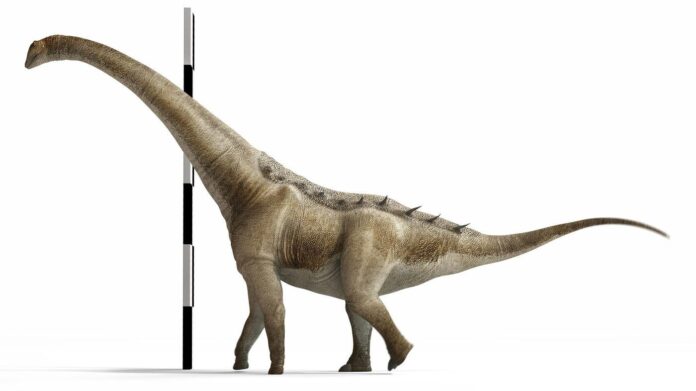
A giant on the Iberian Peninsula: Experts have discovered a dinosaur in Spain that is about 20 meters long and weighs 15 tons. The long-necked herbivore lived about 75 million years ago, explained the researchers from Spain and Portugal. They describe the titanosaur in the journal “Nature Communications Biology”.
The previously unknown species promises important information about dinosaurs shortly before their extinction around 66 million years ago, the researchers write. The presence of the species in Spain reveals that, contrary to what was previously thought, Europe “was a melting pot of native and immigrant sauropods in the late Cretaceous period.”
“Until now, it was thought that almost all European titanosaurs belonged to the native Lirainosaurus genus, which evolved in isolation in Europe from the end of the Cretaceous period until its extinction,” explained co-author Francisco Ortega. The new discovery shows that titanosaurs related to Asian and North American dinosaurs migrated to Europe at the end of the Cretaceous period.
Named after a character from “Don Quixote”
The fossils were discovered at the Lo Hueco archaeological site, around 200 kilometers southeast of Madrid. Ortega emphasized during the presentation to journalists that they are one of the most complete sauropod skeletons ever found in Europe.
The new dinosaur was given the name “Qunkasaura pintiquiniestra”. The first name is made up of the place where it was found, the province of Cuenca, and “Saura”, which alludes to both the Latin word for “lizard” and the painter Antonio Saura. “Pintiquiniestra” is the name of the figure of a giant queen from the book “Don Quixote” by Miguel de Cervantes.
Location promises further revelations
Since its discovery during excavations for the Spanish railway’s high-speed line in 2007, Lo Hueco has been considered one of the most important Upper Cretaceous paleontological sites in Europe. More than 12,000 fossils have been excavated there to date – from sauropods, but also from turtles and crocodiles.
The site is like a textbook on sauropods from the Upper Cretaceous in Europe, said Ortega. Based on the remains, the paleontologists hope to find out more about the living conditions at that time. There is still a lot to discover, said Ortega. “We know that there are remains of at least one other specimen in Cuenca.”
© dpa-infocom, dpa:240908-930-226339/1
This is a message directly from the dpa news channel.
